

I2c. Arduino-cheat-sheet-poster-ide2.jpg (Image JPEG, 1226x862 pixels) Semageek - Page 5. Bon, ceux qui me connaissent savent que je voue une passion de Geek-Harcore a l’univers Star Wars (la seule et unique trilogie) et R2D2 en particulier.
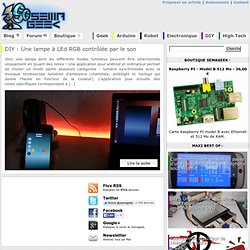
Or, ça faisait un bout de temps que j’avais un R2 qui traînait dans les cartons… Ce petit bonhomme là : Ouais, la photo est dégueulasse, mais elle est […] Moving Forward with Arduino – Chapter 18 – RGB LED Matrix. Arduino Lessons - Electronics. Reference. Référence : Langage Arduino : [ Mini | Standard | Etendue | Maxi ] Librairies : [ Vue d'ensemble | Synthèse ] Infos : [ Comparaison | Changements ] Nouveau : Découvrez nos kits de machines opensource et notre nouveau site dédié !
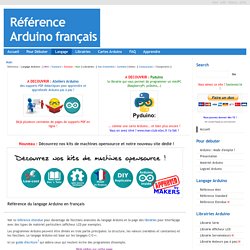
Voir la référence étendue pour davantage de fonctions avancées du langage Arduino et la page des librairies pour interfaçage avec des types de matériel particuliers (afficheur LCD par exemple). Les programmes Arduino peuvent être divisés en trois partie principales: la structure, les valeurs (variables et constantes) et les fonctions. Le langage Arduino est basé sur les langages C/C++. Ici un guide d'écriture? Déjà visites sur cette page. Up/ down counter (switch bounce)- FA1updwn.htm. Bookmark this on Delicious HOME > > ARDUINO LANGUAGE COURSE t.o.c.

An "up/ down" counter, binary, and switch bounce This is one of a collection of pages which, together, attempt to show you "everything" about the Arduino's programming language. There is a page for you with more information about the project in general, and the way these pages are organized, if you want that. Please visit my page about power browsing notes sometime. This page, and the software it references, ©TK Boyd, 1/2010. Where we're going While this topic introduces few concepts that are new, it does take a new look at some things we've seen already, and touches on some details I spared you earlier. Peggy 2LE Light Emitting Pegboard kit. Peggy 2 LE is a smaller version of our "Peggy 2" light-emitting pegboard display.
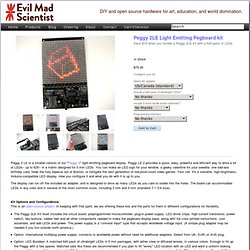
Peggy LE 2 provides a quick, easy, powerful and efficient way to drive a lot of LEDs-- up to 625-- in a matrix designed for 5 mm LEDs. You can make an LED sign for your window, a geeky valentine for your sweetie, one bad-ass birthday card, freak the holy bejesus out of Boston, or instigate the next generation of low-pixel-count video games. Your call. It's a versatile, high-brightness, Arduino-compatible LED display. How you configure it and what you do with it is up to you. The display can run off the included ac adapter, and is designed to drive as many LEDs as you care to solder into the holes. Peggy Planner. Peggy 2.0 + Quartz Composer = Video Peggy! June 29, 2008 (last updated October 24, 2008)
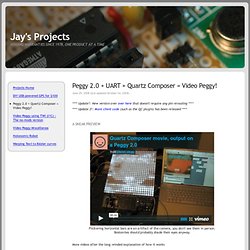
Peggy 2 « Dual Elephants. I had such fun writing the simple ‘snake’ game for my peggy 2 that I wrote a bunch of other games for it as well.

At the moment there is Snake, Breakout, Pong and Race. You can download the sketch as peggy2_games_0.1.zip When compiled it takes up 11432 bytes (it includes the ‘Tone’ library as I have started adding sound to the sketch – connect speaker to ADC5 to hear it) Starting peggy2_game When you turn on the peggy2 a menu is presented displaying the available games – you can select from them using the up/down buttons and select with the ‘select’ or ‘any’ button on the left of the peggy2.
Playing the games. Bionic Arduino – Introduction to Microcontrollers with Arduino. Bionic Arduino is a set of four 3-hour classes in November 2007 hosted by Machine Project and taught by Tod E.
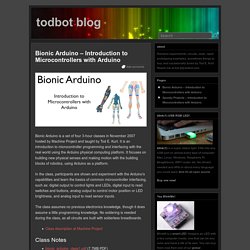
Kurt. It is an introduction to microcontroller programming and interfacing with the real world using the Arduino physical computing platform. It focuses on building new physical senses and making motion with the building blocks of robotics, using Arduino as a platform. In the class, participants are shown and experiment with the Arduino’s capabilities and learn the basics of common microcontroller interfacing, such as: digital output to control lights and LEDs, digital input to read switches and buttons, analog output to control motor position or LED brightness, and analog input to read sensor inputs. The class assumes no previous electronics knowledge, though it does assume a little programming knowledge.
Playground - I2C. PlanetArduino. Controlling 500 LEDs with PWM - Electronics and Robotics - Stack Exchange. LEDMatrix : MondoMatrix. Click images to enlarge Description The LEDMatrix is a MondoMatrix expansion board that can control up to 64 tri-color RGB (4pin) LEDs.

The board can also be used to control 192 individual LEDs. Each LED can be controlled to have a degree of luminance between 0 and 255. This means that you can have one tri-color RGB LED (per ‘port’) that has color values between 0 and 255 for each of the three colors. Important note about expansion boards: All MondoMatrix expansion boards must be connected to the main controller (Displayduino) to work. Specifications LEDMatrix Introduction Video: Network Checklist: Make sure a Displayduino controller is at the beginning of your network connecting to A, B and G terminals of all expansion boards on the network.Make sure the LED power supply is dedicated to powering the LEDs.